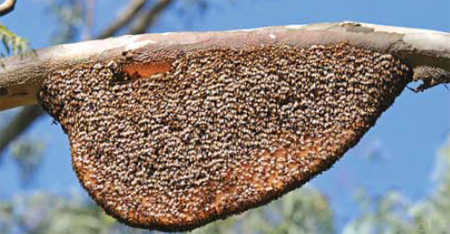
If you associate bees only with painful stings, it’s time to rethink about these hard-working insects. Bees are essential to our planet: The world’s 20,000-plus bee species help pollinate at least 75 percent of earth’s flowering plants, enable farmers to grow crops, and support global biodiversity. Here are some of the key ways that bees help us - and a few things you can do to help them.
Bees help flowering plants reproduce
Without flowering plants, there would be very few bees; and without bees, there would be far fewer plants. Bees land on flowers to gather nectar and pollen as food - and, at the same time, they help plants reproduce. A flower generates pollen in its anther, a part of the stamen or male organ. The pollen grains stick to tiny, stiff hairs on a bee’s body as it crawls around on the petals.
When the bee visits another flower of the same species, it deposits the pollen on that flower’s pistil, or female organ, and fertilises the plant.
This might seem like a haphazard way for plants to ensure their survival, but bees are called “busy” for a reason. According to the Food and Agricultural Organisation of the United Nations (FAO), a single bee can visit several thousand flowers per species in just one day, picking up pollen from some and dispersing it to many others.
Bees support biodiversity
 Some plants can be pollinated with their own pollen, but it’s not ideal. They end up bearing fewer seeds, and the resulting plants are less healthy. But flowering plants fertilised with pollen from the same species have a better chance of survival thanks to their greater genetic diversity. Bees assist by carrying pollen - containing a plant’s DNA - from plant to plant. This way, bees help maintain or even increase the genetic variety of plants in a given area. In a biodiverse environment, more species of plants and animals can thrive amid various threats and stressors.
Some plants can be pollinated with their own pollen, but it’s not ideal. They end up bearing fewer seeds, and the resulting plants are less healthy. But flowering plants fertilised with pollen from the same species have a better chance of survival thanks to their greater genetic diversity. Bees assist by carrying pollen - containing a plant’s DNA - from plant to plant. This way, bees help maintain or even increase the genetic variety of plants in a given area. In a biodiverse environment, more species of plants and animals can thrive amid various threats and stressors.
Though bees help biodiversity by spreading pollen around, they actually keep airborne pollen low. Without bees, the larger number of insect-pollinated plant species would decline and the smaller number of wind-pollinated species would balloon, along with their fine, powdery pollen - exacer bating seasonal allergies for millions of people Bees are essential for producing the world’s food about 75 percent of the world’s food crops are pollinated at least in part by insects, and more than 100 commercial crops require bee pollination. In the U.S., bee - pollinated crops include nutrient-dense fruits and veggies such as apples, squash, broccoli, watermelon, cantaloupe, cranberries, and much more. Even cocoa relies on insect pollination, as do fiber crops such as cotton and agricultural commodities like alfalfa.
Before the 20th century, farmers relied on wild bees to pollinate their crops. Today, with the world’s increasing population and demand for food, most crops are pollinated by domesticated honey bees (Apis mellifera). Using non-native honey bees for pollination in the U.S. has increased food production and even fostered a wave of urban bee-keeping — but it has also led to the decline of some native wild bee populations.
Threats to bees and our planet
Despite how much we rely on bees, human activity is threatening their survival. In addition to honey bee populations out-competing against them, wild bees face habitat loss from agricultural practices that fragment the natural landscape and deplete their food supply. Pesticide use, pathogens, and parasites weaken wild bee populations and may contribute to colony collapse and disorder in honey bees.
Climate change also threatens to upend the synchrony between plant blooming and the availability of pollinators, decreasing biodiversity. According to the FAO, 40 per cent of the world’s invertebrate pollinators are at risk of extinction today.
How to help bees bounce back
Now for the good news: Humans can take steps to help bees recover. If you have a garden (or a patch of lawn you’re ready to convert), plant grasses, flowers, shrubs, and trees that are native to the region where you live.
Native plants will provide habitat and food sources not only for native bees - some of whom have evolved to depend on specific native species - but also for other pollinators, such as moths, butterflies, birds and bats. Avoiding insecticides (which kill bees) will also help bees thrive.
You can further attract and support bees by offering them a water source, such as a shallow birdbath with places to perch. Because many wild bees don’t live in hives, they need nesting sites: Build a ‘bee hotel’ (or buy one online) so these solitary insects have a safe spot to raise the next generation of pollinators.
Source : Internet
